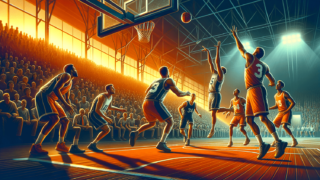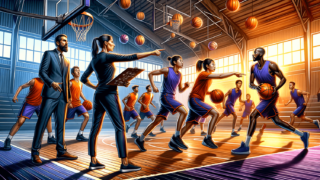
Ever wondered why your favorite basketball team suddenly turns up the defensive heat mid-court, leaving the opposing team flustered and scrambling? Chances are they’re running the famed 2-2-1 half-court press! In this blog post, we’ll dive deep into this striking defensive tactic that has been instrumental in shaping the outcome of many intense games. So, if you’ve got an insatiable desire to boost your basketball strategy expertise, buckle up as we explore the intricacies of the 2-2-1 half-court press and illuminate how to execute it with both flair and finesse.
What’s a 2-2-1 Half-Court Press in Basketball?
The 2-2-1 half-court press is a basketball defensive strategy that focuses on applying pressure to the offensive team as they attempt to advance the ball past the mid-court line. It’s named for the particular positioning of the defenders, with 2 players stationed near the half-court line or pressuring the ball-handler, 2 players waiting in the middle area, and 1 player guarding the basket. The objective is to force turnovers, create steals, and disrupt the offensive team’s rhythm, ultimately gaining control of the ball and increasing scoring opportunities for the defensive team.
Unlocking the Secrets of the 2-2-1 Half-Court Press
Now that we have a basic understanding of the 2-2-1 half-court press, let’s deconstruct its components and spell out why this strategy is such a disruptive force on the basketball court. We’ll go through the positions, player responsibilities, common techniques, and even some coaching tips to ensure you have a complete grasp of this intense defensive tactic. So, prepare to transform your favorite squad into a formidable defensive powerhouse!
Defensive Positions in the 2-2-1 Half-Court Press
As the name implies, the 2-2-1 half-court press relies on placing the defensive players in specific locations on the court. This strategic positioning aims to create passing lanes in which the defense can double up on the offensive players and force mistakes. Let’s examine the roles of each defender in this daring tactic:
Front Two Defenders (First Line of Defense)
At the front line of the 2-2-1 half-court press are the two defenders near the half-court line. These players need the speed and agility necessary to pressure the ball-handler effectively while they navigate across the court. The primary task of these front defenders is to make it difficult for the offensive team to complete accurate passes while maintaining constant pressure on the ball-handler. The moment the offense attempts a pass, these defenders should be positioned to intercept or deflect the ball.
Middle Two Defenders (Second Line of Defense)
The second line of the 2-2-1 half-court press consists of two defenders stationed around the mid-court area, just behind the front two defenders. Their primary responsibility is to read the offensive team’s passing lanes and be prepared to disrupt their flow. These middle defenders also need to be ready to provide support in case an offensive player slips past the first line of defense. Communication and anticipation are vital skills for these players to succeed in their roles.
Back Defender (Last Line of Defense)
The anchor of the 2-2-1 half-court press is the lone defender near the basket. This player must be a versatile, confident shot-blocker and skilled rebounder. As the opponents manage to break through the first and second lines of defense, the back defender will need to contest shots, prevent easy layups, and safeguard against one-on-one matchups. Vigilance and court awareness are essential qualities for this player to excel in this position.
Effective Techniques for Enforcing the 2-2-1 Half-Court Press
Now that we have a clear understanding of the 2-2-1 half-court press’s structure and player responsibilities, let’s turn our attention to the critical techniques that propel this defense into action. Equip yourself with these tools, and you’ll be dominating the court in no time.
Double Teaming the Ball-Handler
The 2-2-1 half-court press aims to neutralize the opposing team’s capabilities by creating ample pressure. One method of achieving this is by double-teaming the ball-handler. With the first and second lines of defense in close vicinity, defenders can momentarily double-up on the ball-handler, forcing a hurried pass or even a turnover.
Jumping the Passing Lanes
Jumping the passing lanes is a crucial aspect of the 2-2-1 half-court press. Essentially, the defenders, especially those in the middle two positions, must anticipate the offensive team’s passing routes and be ready to intercept the ball before it reaches the intended receiver. This tactic requires a keen sense of court awareness, with defenders able to predict the offensive team’s movements and exploit any weaknesses.
Forcing the Offense to the Sidelines
Another important technique within the 2-2-1 half-court press is pushing the offense towards the sidelines, effectively limiting their options. As the ball-handler is pressured into moving closer to the sidelines, they may become trapped, creating an opportunity for the defenders to force a turnover or cause them to step out of bounds.
Controlling the Tempo
The 2-2-1 half-court press is all about controlling the tempo of the game, forcing opponents to adjust to the defensive team’s rhythm. This relentless pressure on the offensive team creates a tense atmosphere, in which they have to think and act quickly to avoid mistakes, resulting in interrupted offensive plays and a higher likelihood of turnovers.
Coaching Tips for Implementing the 2-2-1 Half-Court Press
As a basketball coach or captain, successfully implementing the 2-2-1 half-court press requires a specific set of strategies focused on fostering the skills and techniques necessary for the team to excel in this defensive endeavor. Keep these practical tips in mind when incorporating this potent strategy:
Selecting the Right Personnel
Matching the unique requirements of the 2-2-1 half-court press with each player’s skillset on your team is vital for success. Carefully evaluate your players’ attributes—speed, versatility, court awareness, and communication—and assign them to appropriate positions within the press. Ensure your front and middle defenders possess athleticism and agility, while the back defender exhibits shot-blocking prowess and rebounding aptitude.
Focusing on Communication
In the heat of an intense game, effective communication among players is essential for the smooth execution of the 2-2-1 half-court press. Developing a culture of communication, on and off the court, translates to exceptional teamwork that helps players anticipate each other’s moves, reinforcing their defensive prowess.
Emphasizing Defensive Drills
Adding specialized defensive training to your team’s practice regimen is vital for improving their ability to execute the 2-2-1 half-court press. Focus on drills aimed at enhancing speed, footwork, and court awareness. Utilize activities that emphasize jumping passing lanes, trapping opponents, and double-teaming the ball-handler.
Studying the Opponents
Preparing your team to use the 2-2-1 half-court press effectively also requires studying your opponents. Uncover their habits, strategies, and key players to better understand their offensive style. This valuable insight helps you tailor the 2-2-1 half-court press to exploit their weaknesses, ultimately enabling you to control the tempo of the game and emerge victorious.
Armed with the know-how of one of basketball’s most potent defensive strategies, your team is now ready to hit the hardwood with newfound confidence and finesse. Mastering the 2-2-1 half-court press can be a process filled with challenges, but the end result is well worth the effort. As you dominate the court à la professional defensive maestros, rest assured that the spirit of competitive basketball will be alive and thriving in your camp!
Transitioning from a 2-2-1 Half-Court Press to Offense
Successfully executing a 2-2-1 half-court press often results in turnovers, steals, and shot-clock violations by the opposing team. However, capitalizing on these favorable situations by quickly transitioning into offense is essential to maximizing the benefits of the press. Here are some helpful tips to ensure a smooth and efficient transition:
Pushing the Ball Up the Court
Immediately after gaining control of the ball through a turnover or steal, encourage your players to push the ball up the court. This rapid pace catches the opposing team off-guard and increases the likelihood of scoring before they can set up their defense.
Spacing and Court Awareness
As your team transitions from defense to offense, it’s crucial for players to maintain proper spacing and court awareness. Recognizing open teammates and available passing options ensures that the ball moves efficiently across the court, keeping the opposition on their heels.
Utilizing Fast Breaks
Fast breaks are an excellent way to exploit the disarray of the opposing team after successful execution of the 2-2-1 half-court press. Train your players to recognize fast-break opportunities, and encourage them to push the pace when safe to do so, aiming for easy scoring opportunities.
Adjusting the 2-2-1 Half-Court Press for Different Opponents
No two basketball teams are alike, and the same holds true for your opponents. A one-size-fits-all approach to employing the 2-2-1 half-court press won’t always be effective. To maximize the press’s potency, make strategic adjustments based on the strengths and weaknesses of the opposing team:
Targeting Weak Ball-Handlers
If you identify a weak ball-handler on the opposing team, instruct your front defenders to apply additional pressure to that player. Doing so may increase the chances of forced turnovers and facilitate easier scoring opportunities for your team.
Modifying Press Aggressiveness
Depending on the specific opposing team’s makeup, adjust the level of aggression within your 2-2-1 half-court press. For example, if you face a team that struggles with ball movement, encourage your players to jump passing lanes more aggressively. Conversely, if the opponents excel at penetrating defenses, focus on containing their movements and forcing them toward the sideline traps.
Alternating Front Defender Matchups
Keeping the opposing team guessing is critical in the 2-2-1 half-court press. Make strategic changes to the matchups on the front line by switching the players that pressure the primary ball-handler. These small adjustments can disrupt the offensive team’s rhythm and hinder their planning and execution.
While mastering the 2-2-1 half-court press might be an arduous undertaking, incorporating the techniques suggested above will undoubtedly produce a dominant defensive force on the basketball court. As you continue to refine these skills and adapt to various opponents, both coaches and players will revel in the excitement of success that comes with a well-executed half-court press!
Frequently Asked Questions about the 2-2-1 Half-Court Press
Given the intricacies of the 2-2-1 half-court press in basketball, it’s natural for coaches, players, and enthusiasts to have specific questions about its implementation and effectiveness. In this FAQ section, we address some of the most common queries related to this popular defensive strategy. Take a look and deepen your understanding of this fascinating basketball tactic!
1. What is the primary purpose of using the 2-2-1 half-court press?
The primary purpose of the 2-2-1 half-court press is to create defensive pressure on the offensive team, disrupt their rhythm, and force mistakes such as turnovers or rushed shots. It aims to give the defensive team increased scoring opportunities by hindering the opposing team’s offensive flow.
2. When should a coach implement the 2-2-1 half-court press?
Coaches may choose to implement the 2-2-1 half-court press at various points throughout a game, depending on the situation. It can be an effective tactic during periods when the opposing team appears to be gaining momentum, as it disrupts their rhythm and forces them to adjust their gameplay.
3. Can a team use the 2-2-1 half-court press throughout the entire game?
While it’s possible for a team to use the 2-2-1 half-court press throughout an entire game, it can be physically and mentally taxing for the players. Coaches often employ the press at strategic moments to control the tempo or shift momentum in their favor, rather than using it as a constant strategy.
4. What are the key requirements for players in the 2-2-1 half-court press?
In the 2-2-1 half-court press, players must possess speed, agility, communication skills, and court awareness. Front defenders should excel in pressuring the ball-handler, middle defenders need to anticipate passing lanes, and the back defender requires strong shot-blocking and rebounding skills.
5. How do I prepare my team to execute the 2-2-1 half-court press effectively?
Preparing your team for the 2-2-1 half-court press involves selecting the right personnel for each position, focusing on communication, emphasizing defensive drills, and studying opponents to tailor the press according to their strengths and weaknesses.
6. What offensive strategies can be used to counter the 2-2-1 half-court press?
Offensive teams can counter the 2-2-1 half-court press by ensuring accurate, quick passes, keeping the ball in motion, and using skilled ball-handlers to traverse the court. Exploiting gaps in the defensive structure and initiating fast ball movement can disrupt the press’s effectiveness.
7. How can my team capitalize on the turnovers created by the 2-2-1 half-court press?
To capitalize on turnovers, encourage your team to transition quickly from defense to offense. They should push the ball up the court, maintain proper spacing, and utilize fast breaks whenever it’s advantageous to create easy scoring opportunities.
8. Can the 2-2-1 half-court press be combined with other defensive strategies?
Yes, the 2-2-1 half-court press can be combined with other defensive strategies depending on the team’s needs and the specific matchup. Coaches may seamlessly transition between the half-court press and man-to-man or zone defense during the game to keep opponents guessing and maintain defensive intensity.
9. Can the 2-2-1 half-court press be adapted for youth or recreational league basketball teams?
Yes, the 2-2-1 half-court press can be adapted for use in youth or recreational leagues. Coaches should modify the press’s aggressiveness and pay close attention to developing their players’ fundamental skills, such as speed, agility, and communication, to make the press effective at these levels.
10. Can a full-court press be set up using the 2-2-1 formation?
Yes, the 2-2-1 formation can be utilized in a full-court press scenario. In such cases, the defensive pressure begins immediately after the opposing team gains possession, forcing the offense to navigate the entire court rather than just across the half-court line. The principles of trapping, jumping passing lanes, and controlling the tempo remain similar to those of the half-court variant.
Featured Posts
- No pillar pages found.





